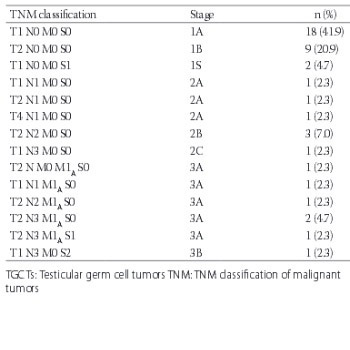K-RAS and N-RAS mutations in testicular germ cell tumors
DOI:
https://doi.org/10.17305/bjbms.2017.1764Keywords:
Testicular germ cell tumors, seminoma, non-seminoma, K-RAS mutation, N-RAS mutation, TGCTAbstract
Testicular cancer is a relatively rare tumor type, accounting for approximately 1% of all cancers in men. However, among men aged between 15 and 40 years, testicular cancer is the most commonly diagnosed malignancy. Testicular germ cell tumors (TGCTs) are classified as seminoma and non-seminoma. The RAS oncogene controls several cellular functions, including cell proliferation, apoptosis, migration, and differentiation. Thus, RAS signaling is important for normal germ cell development. Mutations of the Kirsten RAS (K-RAS) gene are present in over 20% of all cancers. RAS gene mutations have also been reported in TGCTs. We investigated K-RAS and N-RAS mutations in seminoma and non-seminoma TGCT patients. A total of 24 (55%) pure seminoma cases and 19 (45%) non-seminoma cases were included in the study. K-RAS and N-RAS analyses were performed in our molecular pathology laboratory, using K-RAS and N-RAS Pyro Kit 24 V1 (Qiagen). In total, a RAS mutation was present in 12 patients (27%): 7 seminoma (29%) and 5 non-seminoma cases (26%) [p = 0.55]. A K-RAS mutation was present in 4 pure seminoma tumors (16%) and 3 non-seminoma tumors (15%) [p = 0.63], and an N-RAS mutation was observed in 4 seminoma tumors (16%) and 3 non-seminoma tumors (15%) [p = 0.63]. Both, K-RAS and N-RAS mutations were present in two patients: one with seminoma tumor and the other with non-seminoma tumor. To date, no approved targeted therapy is available for the treatment of TGCTs. The analysis of K-RAS and N-RAS mutations in these tumors may provide more treatment options, especially in platinum-resistant tumors.
Citations
Downloads
References
Shanmugalingam T, Soultati A, Chowdhury S, Rudman S, Van Hemelrijck M. Global incidence and outcome of testicular cancer. Clin Epidemiol 2013;5(1):417-27. https://doi.org/10.2147/CLEP.S34430.
Chia VM, Quraishi SM, Devesa SS, Purdue MP, Cook MB, McGlynn KA. International trends in the incidence of testicular cancer, 1973-2002. Cancer Epidemiol Biomarkers Prev 2010;19(5):1151-9. https://doi.org/10.1158/1055-9965.EPI-10-0031.
International Germ Cell Consensus Classification: A prognostic factor-based staging system for metastatic germ cell cancers. International Germ Cell Cancer Collaborative Group. J Clin Oncol 1997;15(2):594-603.
Raghavan D. Testicular cancer: Maintaining the high cure rate. Oncology (Williston Park) 2003;17(2):218-28.
Li J, Xia F, Li WX. Coactivation of STAT and Ras is required for germ cell proliferation and invasive migration in Drosophila. Dev Cell 2003;5(5):787-98. https://doi.org/10.1016/S1534-5807(03)00328-9.
Bamford S, Dawson E, Forbes S, Clements J, Pettett R, Dogan A, et al. The COSMIC (Catalogue of Somatic Mutations in Cancer) database and website. Br J Cancer 2004;91(2):355-8. https://doi.org/10.1038/sj.bjc.6601894.
Moul JW, Theune SM, Chang EH. Detection of RAS mutations in archival testicular germ cell tumors by polymerase chain reaction and oligonucleotide hybridization. Genes Chromosomes Cancer 1992;5(2):109-18. https://doi.org/10.1002/gcc.2870050204.
Chaganti RS, Houldsworth J. Genetics and biology of adult human male germ cell tumors. Cancer Res 2000;60(6):1475-82.
Reuter VE. Origins and molecular biology of testicular germ cell tumors. Mod Pathol 2005;18(Suppl 2):S51-60. https://doi.org/10.1038/modpathol.3800309.
Colicelli J. Human RAS superfamily proteins and related GTPases. Sci STKE 2004;2004(250):RE13. https://doi.org/10.1126/stke.2502004re13.
Lin JS, Webber EM, Senger CA, Holmes RS, Whitlock EP. Systematic review of pharmacogenetic testing for predicting clinical benefit to anti-EGFR therapy in metastatic colorectal cancer. Am J Cancer Res 2011;1(5):650-62.
Sommerer F, Hengge UR, Markwarth A, Vomschloss S, Stolzenburg JU, Wittekind C, et al. Mutations of BRAF and RAS are rare events in germ cell tumours. Int J Cancer 2005;113(2):329-35. https://doi.org/10.1002/ijc.20567.
Ganguly S, Murty VV, Samaniego F, Reuter VE, Bosl GJ, Chaganti RS. Detection of preferential NRAS mutations in human male germ cell tumors by the polymerase chain reaction. Genes Chromosomes Cancer 1990;1(3):228-32. https://doi.org/10.1002/gcc.2870010307.
Price TJ, Bruhn MA, Lee CK, Hardingham JE, Townsend AR, Mann KP, et al. Correlation of extended RAS and PIK3CA gene mutation status with outcomes from the phase III AGITG MAX STUDY involving capecitabine alone or in combination with bevacizumab plus or minus mitomycin C in advanced colorectal cancer. Br J Cancer 2015;112(6):963-70. https://doi.org/10.1038/bjc.2015.37.
Amado RG, Wolf M, Peeters M, Van Cutsem E, Siena S, Freeman DJ, et al. Wild-type KRAS is required for panitumumab efficacy in patients with metastatic colorectal cancer. J Clin Oncol 2008;26(10):1626-34. https://doi.org/10.1200/JCO.2007.14.7116.
Boublikova L, Bakardjieva-Mihaylova V, Skvarova Kramarzova K, Kuzilkova D, Dobiasova A, Fiser K, et al. Wilms tumor gene 1 (WT1), TP53, RAS/BRAF and KIT aberrations in testicular germ cell tumors. Cancer Lett 2016;376(2):367-76. https://doi.org/10.1016/j.canlet.2016.04.016.
Goddard NC, McIntyre A, Summersgill B, Gilbert D, Kitazawa S, Shipley J. KIT and RAS signalling pathways in testicular germ cell tumours: New data and a review of the literature. Int J Androl 2007;30(4):337-48.
https://doi.org/10.1111/j.1365-2605.2007.00769.x.
Skotheim RI, Monni O, Mousses S, Fosså SD, Kallioniemi OP, Lothe RA, et al. New insights into testicular germ cell tumorigenesis from gene expression profiling. Cancer Res 2002;62(8):2359-64.
Feldman DR, Iyer G, Van Alstine L, Patil S, Al-Ahmadie H, Reuter VE, et al. Presence of somatic mutations within PIK3CA, AKT, RAS, and FGFR3 but not BRAF in cisplatin-resistant germ cell tumors. Clin Cancer Res 2014;20(14):3712-20. https://doi.org/10.1158/1078-0432.CCR-13-2868.
Honecker F, Wermann H, Mayer F, Gillis AJ, Stoop H, van Gurp RJ, et al. Microsatellite instability, mismatch repair deficiency, and BRAF mutation in treatment-resistant germ cell tumors. J Clin Oncol 2009;27(13):2129-36. https://doi.org/10.1200/JCO.2008.18.8623.

Downloads
Additional Files
Published
Issue
Section
Categories
How to Cite
Accepted 2017-02-09
Published 2017-05-20









